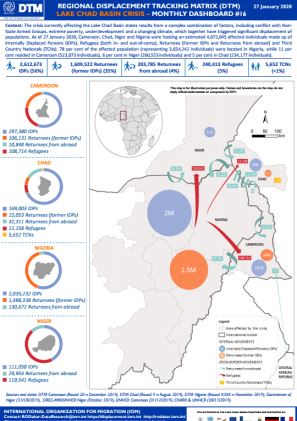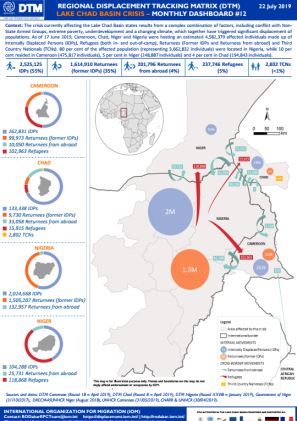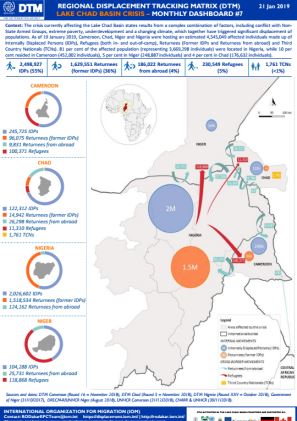-
Countries
-
Data and Analysis
-
Special Focus
-
Crisis Responses
Lake Chad Basin Crisis Monthly Dashboard
Title Standard
West and Central Africa — Lake Chad Basin Crisis Monthly Dashboard # (DATE)
Operation
Contact
Regional Office Dakar, RODakar-DataResearch@iom.int
Type
Component
Domain
Confidential
Region
The crisis currently affecting the Lake Chad Basin states results from a complex combination of factors, including conflict with Non-State Armed Groups, extreme poverty, underdevelopment and a changing climate, which together have triggered significant displacement of populations. As of 27 January 2020, Cameroon, Chad, Niger and Nigeria were hosting an estimated 4,672,045 affected individuals made up of Internally Displaced Persons (IDPs), Refugees (both in- and out-of-camp), Returnees (Former IDPs and Returnees from abroad) and Third Country Nationals (TCNs). 78 per cent of the affected population (representing 3,654,242 individuals) were located in Nigeria, while 11 per cent resided in Cameroon (523,073 individuals), 6 per cent in Niger (260,553 individuals) and 5 per cent in Chad (234,177 individuals).
The crisis currently affecting the Lake Chad Basin states results from a complex combination of factors, including conflict with Non-State Armed Groups, extreme poverty, underdevelopment and a changing climate, which together have triggered significant displacement of populations. As of 17 December 2019, Cameroon, Chad, Niger and Nigeria were hosting an estimated 4,669,100 affected individuals made up of Internally Displaced Persons (IDPs), Refugees (both in- and out-of-camp), Returnees (Former IDPs and Returnees from abroad) and Third Country Nationals (TCNs). 78 per cent of the affected population (representing 3,654,242 individuals) were located in Nigeria, while 11 per cent resided in Cameroon (521,782 individuals), 6 per cent in Niger (258,899 individuals) and 5 per cent in Chad (234,177 individuals).
The crisis currently affecting the Lake Chad Basin states results from a complex combination of factors, including conflict with Non-State Armed Groups, extreme poverty, underdevelopment and a changing climate, which together have triggered significant displacement of populations. As of 25 September 2019, Cameroon, Chad, Niger and Nigeria were hosting an estimated 4,645,660 affected individuals made up of Internally Displaced Persons (IDPs), Refugees (both in- and out-of-camp), Returnees (Former IDPs and Returnees from abroad) and Third Country Nationals (TCNs). 79 per cent of the affected population (representing 3,661,052 individuals) were located in Nigeria, while 10 per cent resided in Cameroon (487,691 individuals), 6 per cent in Niger (258,899 individuals) and 5 per cent in Chad (238,018 individuals).
The crisis currently affecting the Lake Chad Basin states results from a complex combination of factors, including conflict with Non-State Armed Groups, extreme poverty, underdevelopment and a changing climate, which together have triggered significant displacement of populations. As of 25 September 2019, Cameroon, Chad, Niger and Nigeria were hosting an estimated 4,602,569 affected individuals made up of Internally Displaced Persons (IDPs), Refugees (both in- and out-of-camp), Returnees (Former IDPs and Returnees from abroad) and Third Country Nationals (TCNs). 80 per cent of the affected population (representing 3,661,052 individuals) were located in Nigeria, while 10 per cent resided in Cameroon (487,691 individuals), 6 per cent in Niger (258,899 individuals) and 4 per cent in Chad (194,927 individuals).
The crisis currently affecting the Lake Chad Basin states results from a complex combination of factors, including conflict with Non-State Armed Groups, extreme poverty, underdevelopment and a changing climate, which together have triggered significant displacement of populations. As of 17 June 2019, Cameroon, Chad, Niger and Nigeria were hosting an estimated 4,582,379 affected individuals made up of Internally Displaced Persons (IDPs), Refugees (both in- and out-of-camp), Returnees (Former IDPs and Returnees from abroad) and Third Country Nationals (TCNs). Eighty per cent of the affected population (representing 3,662,832 individuals) were located in Nigeria, while ten per cent resided in Cameroon (475,817 individuals), five per cent in Niger (248,887 individuals) and four per cent in Chad (194,843 individuals).
The crisis currently affecting the Lake Chad Basin states results from a complex combination of factors, including conflict with Non-State Armed Groups, extreme poverty, underdevelopment and a changing climate, which together have triggered significant displacement of populations. As of 17 June 2019, Cameroon, Chad, Niger and Nigeria were hosting an estimated 4,425,954 affected individuals made up of Internally Displaced Persons (IDPs), Refugees (both in- and out-of-camp), Returnees (Former IDPs and Returnees from abroad) and Third Country Nationals (TCNs). 79 per cent of the affected population (representing 3,506,407 individuals) were located in Nigeria, while 11 per cent resided in Cameroon (475,817 individuals), 6 per cent in Niger (248,887 individuals) and 4 per cent in Chad (194,843 individuals).
The crisis currently affecting the Lake Chad Basin states results from a complex combination of factors, including conflict with Non-State Armed Groups, extreme poverty, underdevelopment and a changing climate, which together have triggered significant displacement of populations. As of 3 May 2019, Cameroon, Chad, Niger and Nigeria were hosting an estimated 4,454,343 affected individuals made up of Internally Displaced Persons (IDPs), Refugees (both in- and out-of-camp), Returnees (Former IDPs and Returnees from abroad) and Third Country Nationals (TCNs). 79 per cent of the affected population (representing 3,533,147 individuals) were located in Nigeria, while 11 per cent resided in Cameroon (509,253 individuals), 6 per cent in Niger (248,887 individuals) and 4 per cent in Chad (189,796 individuals).
The crisis currently affecting the Lake Chad Basin states results from a complex combination of factors, including conflict with Non-State Armed Groups, extreme poverty, underdevelopment and a changing climate, which together have triggered significant displacement of populations. As of 25 March 2019, Cameroon, Chad, Niger and Nigeria were hosting an estimated 4,443,823 affected individuals made up of Internally Displaced Persons (IDPs), Refugees (both in- and out-of-camp), Returnees (Former IDPs and Returnees from abroad) and Third Country Nationals (TCNs). 79 per cent of the affected population (representing 3,506,407 individuals) were located in Nigeria, while 11 per cent resided in Cameroon (499,295 individuals), 6 per cent in Niger (248,887 individuals) and 4 per cent in Chad (189,234 individuals).
The crisis currently affecting the Lake Chad Basin states results from a complex combination of factors, including conflict with Non-State Armed Groups, extreme poverty, underdevelopment and a changing climate, which together have triggered significant displacement of populations. As of 20 February 2019, Cameroon, Chad, Niger and Nigeria were hosting an estimated 4,385,852 affected individuals made up of Internally Displaced Persons (IDPs), Refugees (both in- and out-of-camp), Returnees (Former IDPs and Returnees from abroad) and Third Country Nationals (TCNs). 80 per cent of the affected population (representing 3,506,407 individuals) were located in Nigeria, while 10 per cent resided in Cameroon (452,002 individuals), 6 per cent in Niger (248,887 individuals) and 4 per cent in Chad (178,556 individuals).
The crisis currently affecting the Lake Chad Basin states results from a complex combination of factors, including conflict with Non-State Armed Groups, extreme poverty, underdevelopment and a changing climate, which together have triggered significant displacement of populations. As of 19 January 2019, Cameroon, Chad, Niger and Nigeria were hosting an estimated 4,545,049 affected individuals made up of Internally Displaced Persons (IDPs), Refugees (both in- and out-of-camp), Returnees (Former IDPs and Returnees from abroad) and Third Country Nationals (TCNs). 81 per cent of the affected population (representing 3,669,298 individuals) were located in Nigeria, while 10 per cent resided in Cameroon (452,002 individuals), 5 per cent in Niger (248,887 individuals) and 4 per cent in Chad (176,632 individuals).
Pagination
- Previous page
- Page 5
- Next page










